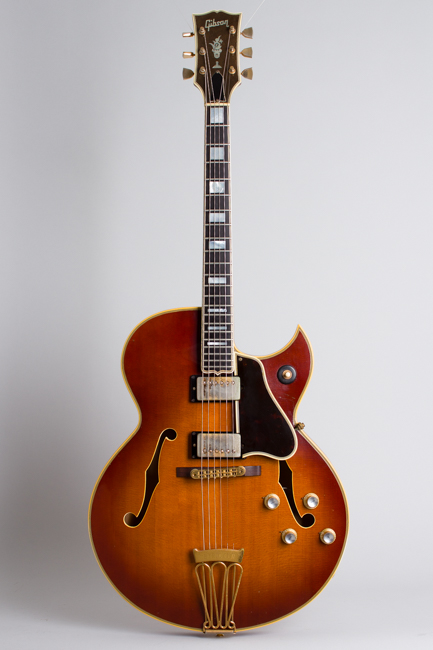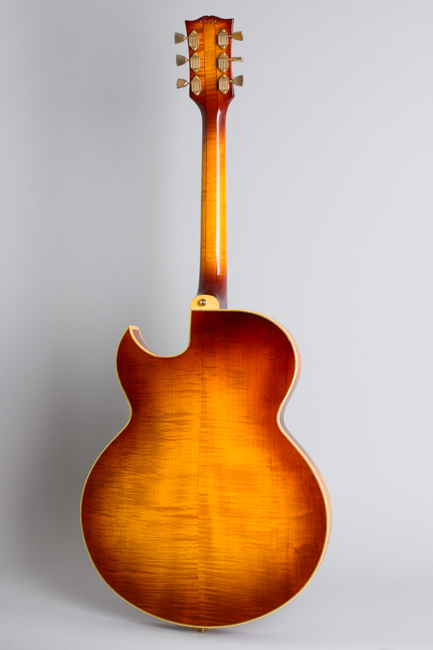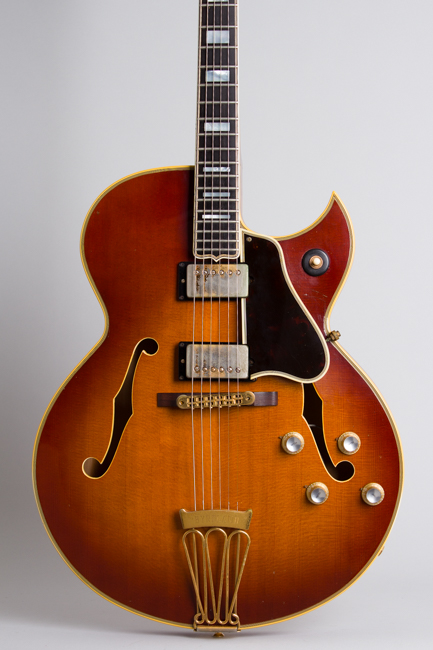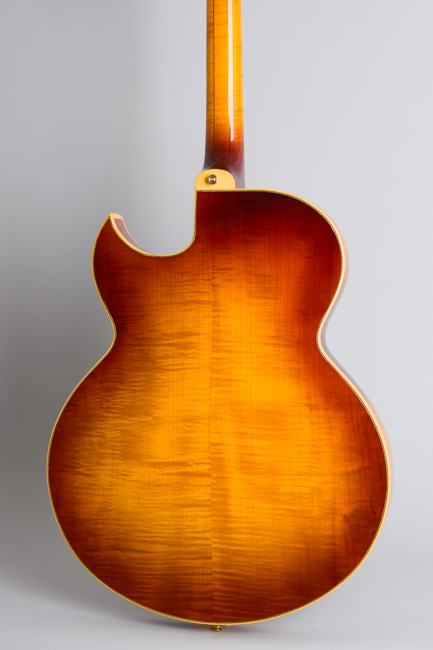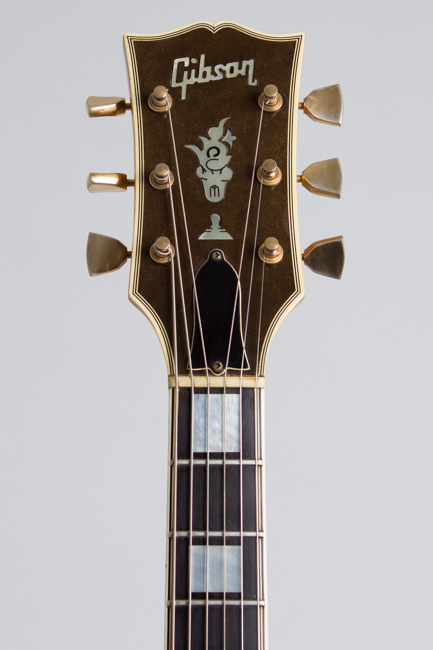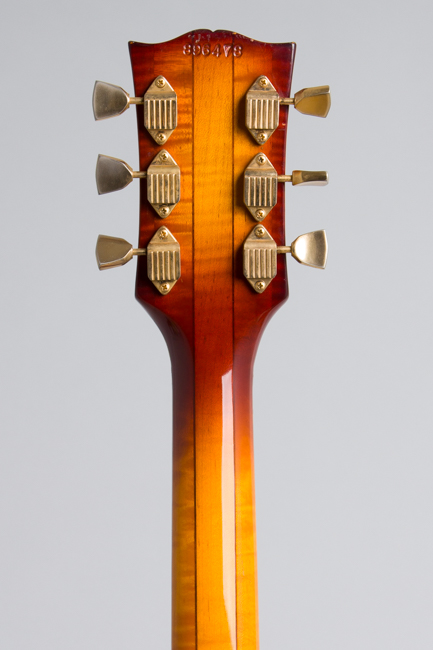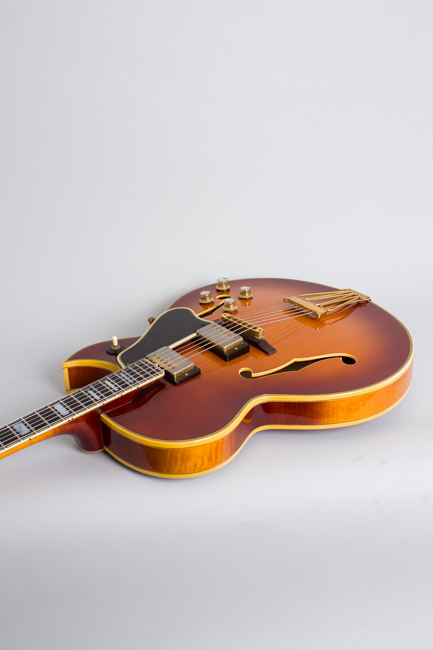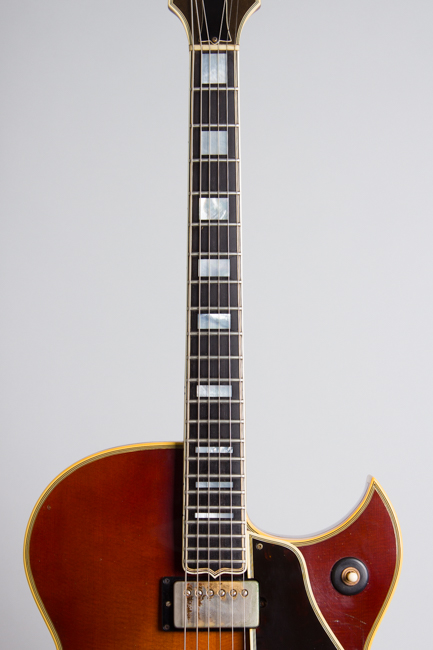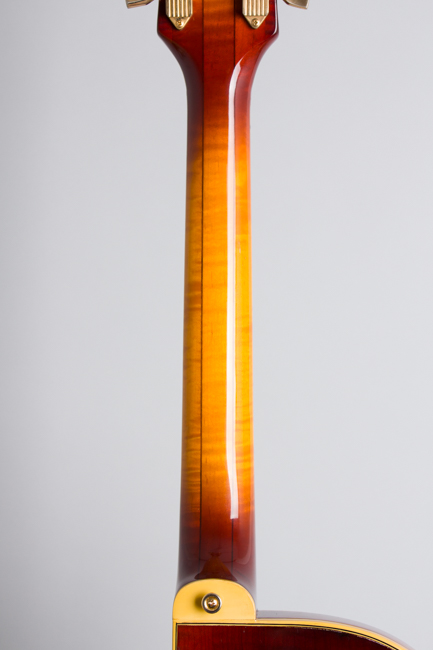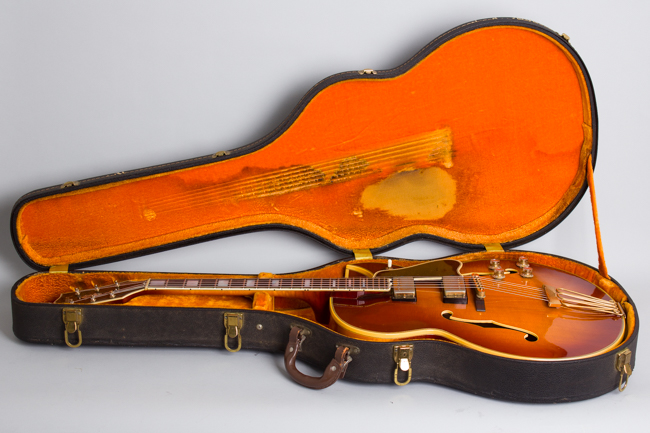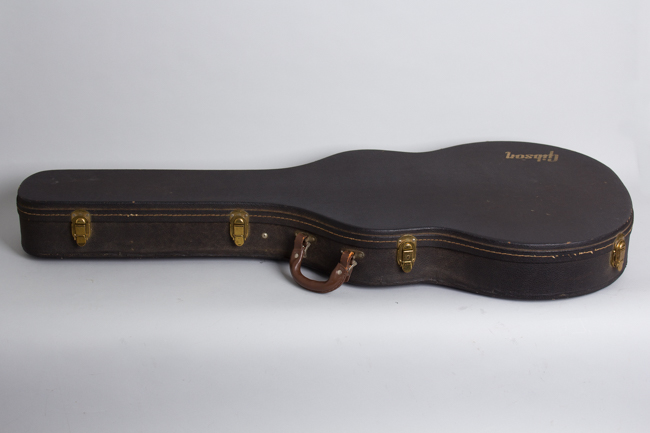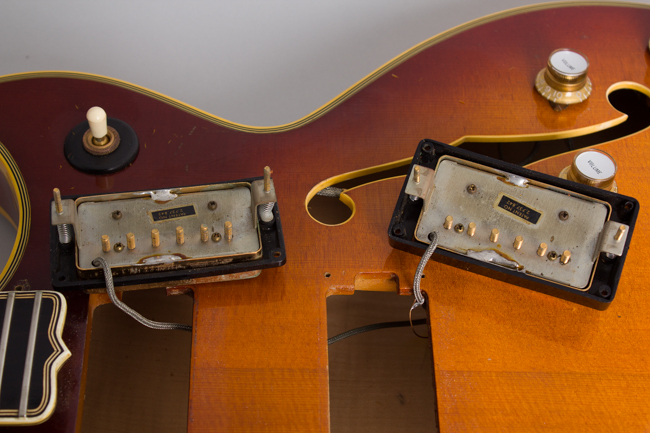Gibson Byrdland Thinline Hollow Body Electric Guitar (1968)
This item is currently on hold.
Item # 11839
Prices subject to change without notice.
Gibson Byrdland Model Thinline Hollow Body Electric Guitar (1968), made in Kalamazoo, Michigan, serial # 896478, sunburst lacquer finish, maple back and sides, spruce top; laminated maple neck with ebony fingerboard, original black hard shell case.
This is a clean 50+ year old example of Gibson's classiest 1960s thinline hollowbody electric, the Byrdland. This model was introduced in 1955 as a more "modern" version of the electrified L-5 arch-top, with features specified by two of the company's Nashville endorsers, Hank Garland and Billy Byrd. These included the same solid, carved wood construction (flame maple and tight-grain spruce) and cosmetics as the L-5CES but with a with a thinner-rimmed body and a shorter scale neck, Garland's key request. The model's name was derived from a contraction of these two player's names, conveniently also reminiscent of a certain famous New York jazz club.
This Byrdland is built on a thin-rim 2 1/8" deep, 17" wide body with a fully carved spruce top. It is finished in a subtly shaded sunburst somewhat darker than many later 1960's Gibsons, with less red hue than many from this decade. The 2-piece maple back has a lovely if fairly subtle flamed grain figure. The neck is a 5-piece maple laminate with a multi bound, pearl block inlaid ebony fingerboard. There is multiple binding everywhere and the headstock bears the L-5 style pearl flowerpot inlay; this one shows another quirk of the period with a gap between the top and bottom sections of this ornament. The neck is slim but not as much as many late '60s Gibsons still with a 1 5/8" nut.
This example is from the end of the 1960s, made just before the '60s sharp Florentine cutaway body reverted back to the old rounded "Venetian" profile the model originally had in the 1950s. This instrument is an interesting transitional example, with what appears to be a 2-piece carved back (a feature re-introduced in 1968-9) coupled with the older sharp cutaway, discontinued at the same time. The serial number should date it to late 1968, although Gibson numbering in this period was fairly erratic. Although Gibson's overall quality is thought to have slipped somewhat in this time, the top-line carved guitars suffered the least; this Byrdland still has the much of feel of a top-quality instrument from an earlier era. This was a very expensive guitar; the list price in June 1968 was $895.00 plus $84 for the case.
The hardware includes two original patent number humbucking pickups with gold plated covers. The rest of the wiring rig has been replaced; the original pots, jack, cans and switch are still in the case. The date visible on those pots is the 45th week of 1967. The metal-capped gold knobs are repros of the style more typical of the earlier '60s, not the later '60s "witch hat" amp-style knobs. The original gold-plated tailpiece is engraved "Byrdland" on the crosspiece. The tuners are Kluson "waffleback" enclosed machines with metal buttons.
The Byrdland has been a high end classic for many decades, known for use by many greats in the in jazz and R&B fields, but also the favorite of players as diverse as Roy Clark and Ted Nugent! This is not an exceptionally rare guitar as 194 were shipped in 1968 (the peak production year in the 1960s) and another 160 in 1969; this still represents a small fraction of the totals for many other period Gibson instruments. This is a very nice example with some replaced parts but still a supremely classy guitar and fine player with the expected classic Gibson sound.
Overall length is 41 3/8 in. (105.1 cm.), 17 in. (43.2 cm.) wide at lower bout, and 2 3/16 in. (5.6 cm.) in depth, measured at side of rim. Scale length is 23 5/16 in. (592 mm.). Width of nut is 1 5/8 in. (41 mm.).
Overall this is a very clean guitar, showing not much actual play wear for 50+ years on the planet. The all-original sunburst finish is beautifully preserved, with some very light wear including scuffing and some tiny dings but little checking or fade. The guitar is crack free (which many of these solid-wood Byrdlands are not) showing no structural repairs.
The guitar does have a mix of hardware from different eras. The Kluson Sealfast tuners, "Patent number" Humbucking pickups and the engraved "Byrdland" tailpiece are original. The gold plated tune-O-Matic bridge on a wooden base is a 1970s Gibson piece, the knobs are modern vintage mid-60s style replacements and the multi bound celluloid pickguard is a beautifully done repro. The original looks to have outgassed some time ago; the pickup covers and bracket in particular show damage to the gold plating from this, as to a lesser extent do the tailpiece and bridge. A strap button has been added to the heel, both it and the one at the rear are of later vintage. As noted the entire wiring rig beyond the pickup leads is a modern replacement, but the original pots, jack, cans, and switch are still in the case pocket, with codes dating to late 1967.
The original frets show very little wear, and this is a truly great sounding and playing guitar. Even not plugged in the carved top gives it a lively sound, and the twin humbuckers offer a wide range of tone from purr to howl, according to preference (and volume level!). It is still housed in the original gold-lined black HSC with a replaced handle and some internal wear, mostly from the pickguard dissolution. Overall Excellent - Condition.
This is a clean 50+ year old example of Gibson's classiest 1960s thinline hollowbody electric, the Byrdland. This model was introduced in 1955 as a more "modern" version of the electrified L-5 arch-top, with features specified by two of the company's Nashville endorsers, Hank Garland and Billy Byrd. These included the same solid, carved wood construction (flame maple and tight-grain spruce) and cosmetics as the L-5CES but with a with a thinner-rimmed body and a shorter scale neck, Garland's key request. The model's name was derived from a contraction of these two player's names, conveniently also reminiscent of a certain famous New York jazz club.
This Byrdland is built on a thin-rim 2 1/8" deep, 17" wide body with a fully carved spruce top. It is finished in a subtly shaded sunburst somewhat darker than many later 1960's Gibsons, with less red hue than many from this decade. The 2-piece maple back has a lovely if fairly subtle flamed grain figure. The neck is a 5-piece maple laminate with a multi bound, pearl block inlaid ebony fingerboard. There is multiple binding everywhere and the headstock bears the L-5 style pearl flowerpot inlay; this one shows another quirk of the period with a gap between the top and bottom sections of this ornament. The neck is slim but not as much as many late '60s Gibsons still with a 1 5/8" nut.
This example is from the end of the 1960s, made just before the '60s sharp Florentine cutaway body reverted back to the old rounded "Venetian" profile the model originally had in the 1950s. This instrument is an interesting transitional example, with what appears to be a 2-piece carved back (a feature re-introduced in 1968-9) coupled with the older sharp cutaway, discontinued at the same time. The serial number should date it to late 1968, although Gibson numbering in this period was fairly erratic. Although Gibson's overall quality is thought to have slipped somewhat in this time, the top-line carved guitars suffered the least; this Byrdland still has the much of feel of a top-quality instrument from an earlier era. This was a very expensive guitar; the list price in June 1968 was $895.00 plus $84 for the case.
The hardware includes two original patent number humbucking pickups with gold plated covers. The rest of the wiring rig has been replaced; the original pots, jack, cans and switch are still in the case. The date visible on those pots is the 45th week of 1967. The metal-capped gold knobs are repros of the style more typical of the earlier '60s, not the later '60s "witch hat" amp-style knobs. The original gold-plated tailpiece is engraved "Byrdland" on the crosspiece. The tuners are Kluson "waffleback" enclosed machines with metal buttons.
The Byrdland has been a high end classic for many decades, known for use by many greats in the in jazz and R&B fields, but also the favorite of players as diverse as Roy Clark and Ted Nugent! This is not an exceptionally rare guitar as 194 were shipped in 1968 (the peak production year in the 1960s) and another 160 in 1969; this still represents a small fraction of the totals for many other period Gibson instruments. This is a very nice example with some replaced parts but still a supremely classy guitar and fine player with the expected classic Gibson sound.
Overall length is 41 3/8 in. (105.1 cm.), 17 in. (43.2 cm.) wide at lower bout, and 2 3/16 in. (5.6 cm.) in depth, measured at side of rim. Scale length is 23 5/16 in. (592 mm.). Width of nut is 1 5/8 in. (41 mm.).
Overall this is a very clean guitar, showing not much actual play wear for 50+ years on the planet. The all-original sunburst finish is beautifully preserved, with some very light wear including scuffing and some tiny dings but little checking or fade. The guitar is crack free (which many of these solid-wood Byrdlands are not) showing no structural repairs.
The guitar does have a mix of hardware from different eras. The Kluson Sealfast tuners, "Patent number" Humbucking pickups and the engraved "Byrdland" tailpiece are original. The gold plated tune-O-Matic bridge on a wooden base is a 1970s Gibson piece, the knobs are modern vintage mid-60s style replacements and the multi bound celluloid pickguard is a beautifully done repro. The original looks to have outgassed some time ago; the pickup covers and bracket in particular show damage to the gold plating from this, as to a lesser extent do the tailpiece and bridge. A strap button has been added to the heel, both it and the one at the rear are of later vintage. As noted the entire wiring rig beyond the pickup leads is a modern replacement, but the original pots, jack, cans, and switch are still in the case pocket, with codes dating to late 1967.
The original frets show very little wear, and this is a truly great sounding and playing guitar. Even not plugged in the carved top gives it a lively sound, and the twin humbuckers offer a wide range of tone from purr to howl, according to preference (and volume level!). It is still housed in the original gold-lined black HSC with a replaced handle and some internal wear, mostly from the pickguard dissolution. Overall Excellent - Condition.
